Sleep is undeniably vital for our overall well-being, with numerous studies emphasizing its importance for both physical and mental health. However, for millions of people around the world, a good night’s sleep remains elusive due to a condition known as sleep apnea.
Although the most common type, Obstructive Sleep Apnea (OSA), often steals the spotlight, Central Sleep Apnea (CSA) is a lesser-known but equally significant concern. Fortunately, recent advancements in sleep medicine have led to the emergence of a promising treatment for CSA: BiPAP therapy.
In this blog post, we will delve into the intricacies of CSA, explore how BiPAP works, and examine its potential to transform the lives of those afflicted with this challenging sleep disorder. Buckle up and join us on this fascinating journey into sleep medicine and the hope that this type of therapy brings to those battling central sleep apnea.
Understanding Central Sleep Apnea (CSA)

Central Sleep Apnea (CSA) is a type of sleep disordered breathing characterized by the periodic cessation of breathing during sleep due to a lack of respiratory effort. Unlike Obstructive Sleep Apnea (OSA), which occurs when the airway becomes blocked, CSA results from the brain’s failure to send appropriate signals to the muscles responsible for controlling breathing. This lack of communication disrupts the regular breathing pattern, leading to multiple episodes of interrupted breathing throughout the night.
Cause
CSA’s causes can vary, including medical conditions such as heart failure, stroke, or conditions affecting the brainstem. In some cases, CSA can also be idiopathic, meaning that the cause is unknown. Certain medications, like opioids, can also contribute to the development of CSA.
Symptoms
Symptoms of CSA may be similar to those of OSA. They can include excessive daytime sleepiness, snoring, restless sleep, frequent awakenings, morning headaches, and difficulty concentrating during the day. However, unlike OSA, CSA patients might also experience shortness of breath that wakes them up or episodes of suddenly waking up with a feeling of choking or gasping for air.
Diagnosis
Diagnosis of CSA typically involves a comprehensive evaluation by a healthcare professional, which may include a detailed medical history, a physical examination, and an overnight sleep study called polysomnography. During the sleep study, the patient’s brain activity, heart rate, breathing patterns, oxygen levels, and body movements are monitored to identify the presence and severity of sleep apnea.
What happens if untreated?
Untreated CSA can lead to various complications and risks, such as cardiovascular issues (e.g., heart failure, arrhythmias, and stroke), impaired cognitive function, mood disorders (e.g., depression and anxiety), and a decreased quality of life.
Traditional treatment options for CSA include optimizing the management of underlying medical conditions, addressing medication-related causes, using supplemental oxygen, and employing various Positive Airway Pressure (PAP) therapies like CPAP, Adaptive Servo-Ventilation (ASV), and, as we will explore further, BiPAP.
BiPAP Therapy: How It Works

Image source: healthline.com
BiPAP, which stands for Bilevel Positive Airway Pressure, is a form of non-invasive ventilation that helps patients maintain adequate breathing during sleep by providing two distinct levels of pressure: one for inhalation (inspiratory positive airway pressure therapy, or IPAP) and a lower one for exhalation (expiratory positive airway pressure, or EPAP).
To begin with, let’s explore the components of a BiPAP machine. The essential elements include:
- A small air compressor.
- A mask that fits over the nose and/or mouth.
- A set of tubing to connect the mask to the machine.
- A humidifier moistens the pressurized air.
The machine is programmed to deliver the appropriate pressures based on the patient’s needs, as determined by a sleep specialist.
Understanding BiPAP Machines
BiPAP machines, also known as bilevel positive airway pressure machines, offer advanced comfort features and enhanced therapy options compared to most CPAP machines. These machines utilize automatic positive airway pressure technology to deliver customized air pressure levels for optimal therapy.
BiPAP machines are non-invasive medical devices designed to assist individuals with breathing difficulties, such as:
- Sleep apnea
- COPD (Chronic Obstructive Pulmonary Disease)
- Other respiratory conditions.
They deliver pressurized air into the airways, helping to keep them open during inhalation and exhalation. Unlike CPAP (Continuous Positive Airway Pressure) machines that provide constant pressure, BiPAP machines offer two different pressure levels:
- Higher pressure during inhalation
- Lower pressure during exhalation
Also Read: CPAP vs BiPAP Machine: Which One Is Right For You?
Differences Between CPAP And BiPAP Machines
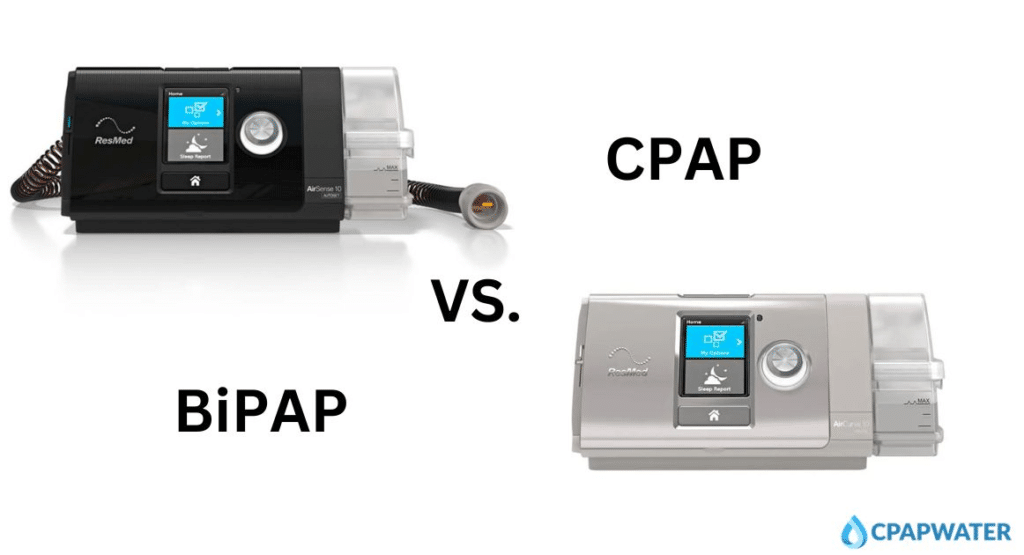
While both CPAP and BiPAP machines are used for respiratory support, they have fundamental differences. CPAP machine deliver constant, continuous pressure throughout the breathing cycle, helping to keep the airways open.
On the other hand, BiPAP machines provide two distinct pressure levels: a higher inspiratory pressure to assist with inhalation and a lower expiratory pressure to aid exhalation. This bi-level pressure delivery of BiPAP machines can be beneficial for individuals who require varying pressure levels based on their respiratory needs.
Advantages of BiPAP Therapy for CSA Patients
BiPAP presents several benefits that can improve sleep quality, alleviate symptoms, and enhance overall well-being for individuals with CSA.
First and foremost, this therapy enhances patient comfort and compliance. The separate pressures for inhalation and exhalation make it easier for patients to breathe out against the airflow, reducing the discomfort and claustrophobic feeling that some individuals experience with other PAP therapies like CPAP. This increased comfort often leads to better adherence to treatment, which is crucial for long-term success.
Another significant advantage of this therapy is the improvement in ventilation and oxygenation. For CSA patients, who may struggle with maintaining proper breathing due to a lack of respiratory effort, BiPAP can provide the necessary pressure support to ensure consistent and adequate airflow during sleep. This helps prevent drops in oxygen levels and keeps the airway open, reducing the number of apneas and hypopneas experienced throughout the night.
Additionally, BiPAP can lead to a reduction in symptoms and complications associated with untreated CSA. By effectively managing the patient’s breathing patterns and maintaining adequate ventilation, this therapy can alleviate excessive daytime sleepiness, improve cognitive function, and reduce the risk of cardiovascular issues such as heart failure, arrhythmias, and stroke.
Finally, the personalization and adaptability of BiPAP cater to each patient’s unique needs. A sleep specialist can fine-tune the pressure settings to ensure optimal sleep apnea treatment outcomes. Furthermore, advanced BiPAP machines can automatically adjust pressure levels in real time based on the patient’s breathing, providing a tailored and responsive therapy experience.
What You Should Consider When Choosing A BiPAP Machine
When purchasing a BiPAP machine, there are several important factors to consider. Each of these considerations plays a significant role in finding the suitable BiPAP machine that suits your needs and ensures effective respiratory therapy.
Device Climate Control
While not essential, climate control options can significantly enhance your BiPAP therapy experience. Integrated humidifiers can prevent dryness in your airway by adding moisture to the pressurized air. Aftermarket humidifier accessories are available if your machine doesn’t include a built-in humidifier. Heated tubing is another helpful feature that warms the air, improving comfort and maintaining optimal humidity levels.
Pressure Range
BiPAP machines typically offer a more comprehensive pressure range compared to CPAP machines. While CPAP machines generally range from 4 to 20 cm H2O, BiPAP machines often span from 4 to 25 cm H2O. Your doctor will determine the appropriate pressure setting for your specific treatment requirements.
Ramp Options
Many BiPAP machines offer ramp settings to ensure a comfortable transition into sleep. These settings gradually increase the air pressure over a set period, allowing ample time to fall asleep before reaching the final prescribed pressure setting.
Sound Level
Modern BiPAP machines have come a long way in terms of noise reduction. While they were once notorious for their noise levels, today’s models can be remarkably quiet, with average sound levels ranging from 25 to 30 dB – similar to a whisper. These more silent machines are unlikely to disturb even light sleepers.
Data Tracking
Data tracking is essential for monitoring the effectiveness of your BiPAP therapy and demonstrating treatment adherence, which may be required by insurance providers. Most BiPAP machines have built-in data tracking capabilities, but if your chosen machine lacks this feature, you can purchase a separate data tracking accessory.
Top BiPAP Machines For 2024
ResMed AirCurve BiPAP 10
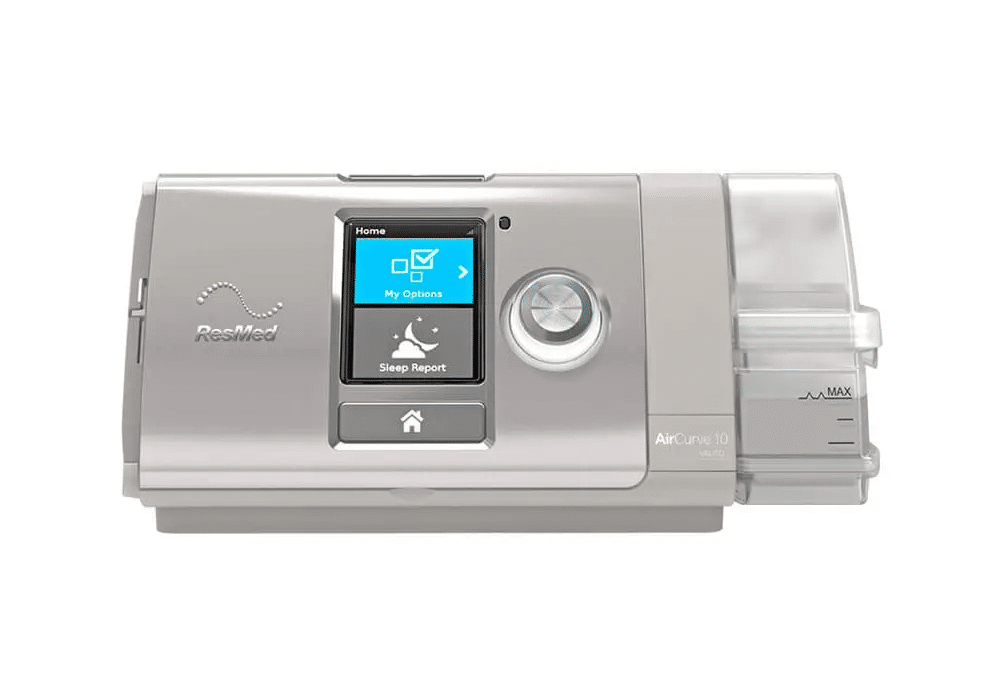
Best For:
- People interested in in-depth data tracking
- Travelers who are often away from their health care team
- Customers looking for a well-built BiPAP machine with luxury features
Who Should Keep Looking:
- Shoppers on a budget
- People who prioritize temperature control features over data tracking
- Users who dislike using smartphone apps
The ResMed AirCurve 10 VAuto BiPAP machine is an exceptional choice in BiPAP machines, offering refined comfort and comprehensive data tracking capabilities. Priced at $2,495, it represents a premium option for those seeking top-of-the-line features. With a diameter of 2.75 lbs. and dimensions measuring 4.57″ x 10.04″ x 5.91″, it strikes a balance between size and functionality. Notably, its noise rating of 27 dBA ensures a peaceful sleep environment.
What sets the AirCurve BiPAP 10 VAuto apart is its well-built design and cutting-edge cellular communication features, enabling seamless data transfer regardless of location. The integrated heated humidifier with adjustable humidity levels guarantees optimal comfort, and for enhanced temperature control, users can leverage ResMed’s ClimateLineAir heated tubing.
Moreover, the machine’s intelligent features and data tracking capabilities are further enhanced through integration with the myAir app. This integration allows users to gain valuable insights into their sleep patterns and the effectiveness of their therapy, ensuring maximum therapeutic comfort.
Also Read: What is myAir Score, And How To Read It?
Luna G3 BiPAP Machine
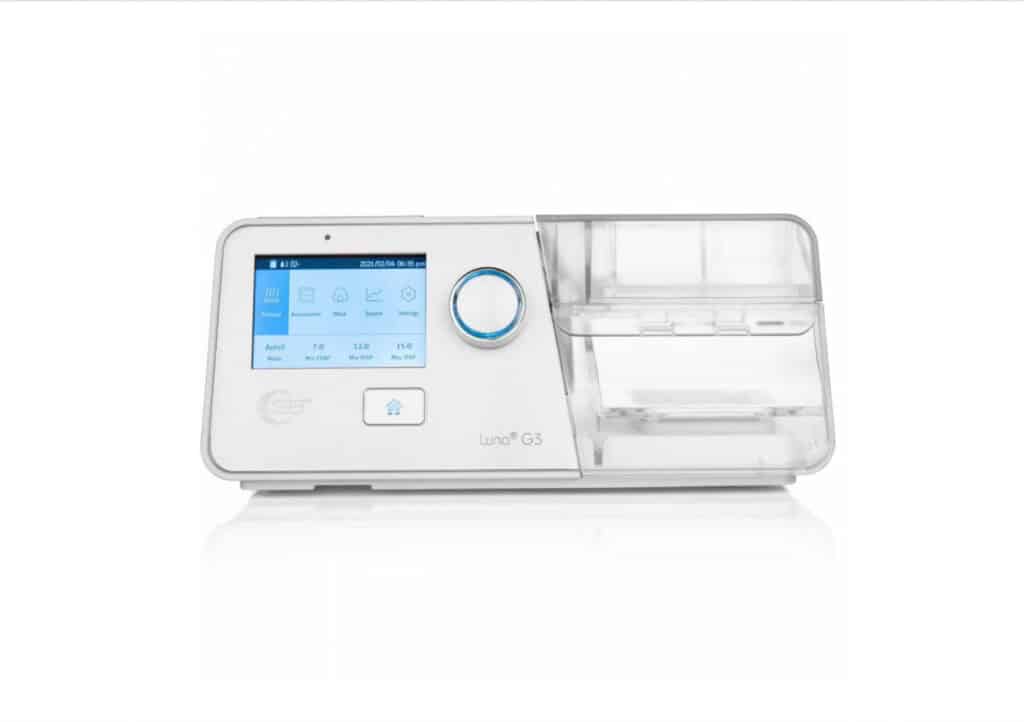
Ideal For:
- People who experience a dry or sore airway with other BiPAP machines
- Light sleepers looking for a very quiet BiPAP machine
- First-time BiPAP users
Who Should Keep Looking:
- People who want advanced smart features
- Frequent travelers who prioritize size over an integrated humidifier
- Users looking for an inexpensive BiPAP machine
The Luna G3 BiPAP Machine, manufactured by 3B Medical, is a sleek, portable option with various advanced features. Priced at $1,999, it offers excellent value for money. It balances compact size and functionality with dimensions measuring 10.43″ x 5.71″ x 4.49″ and weighing 3.75 lbs. Notably, it operates at a low noise rating of 26 dBA, ensuring a peaceful and undisturbed sleep environment.
The machine features heated tubing, an integrated humidifier, and adjustable humidity controls, providing a soothing and personalized therapy experience. Additionally, the automatic ramp setting gradually increases air pressure as users fall asleep, ensuring a gentle transition into therapy.
The Luna’s compact size and compatibility with external batteries make it a perfect choice for travelers who require a portable solution. It’s modern design and user-friendly display add to its appeal, offering a seamless and enjoyable experience. For added peace of mind, the Luna G3 BiPAP Machine is covered by a two-year manufacturer’s warranty, with the included accessories protected under a separate three-month warranty.
Other Prominent BiPAP Machines
IntelliPAP Auto BiLevel
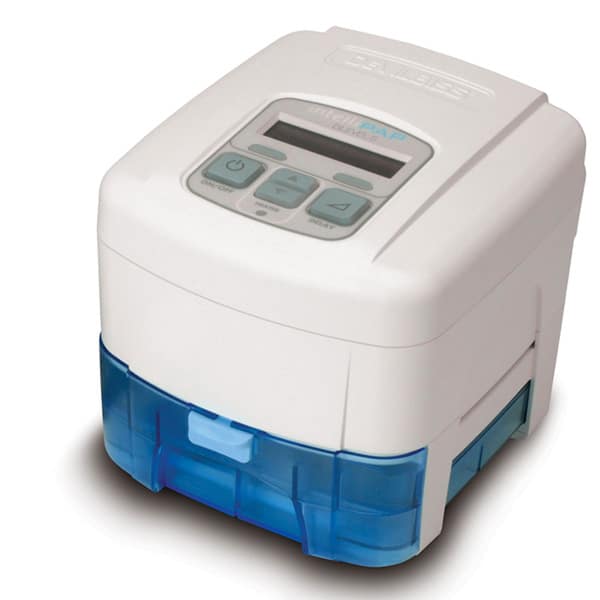
The IntelliPAP Auto BiLevel machine, manufactured by DeVilbiss Healthcare, is a reliable and affordable option for BiPAP therapy. It offers automatic pressure adjustment, ensuring optimal treatment throughout the night. The machine’s compact design and whisper-quiet operation make it suitable for home use. Users appreciate its ease of use, reliability, and value for money.
DreamStation BiPAP Auto
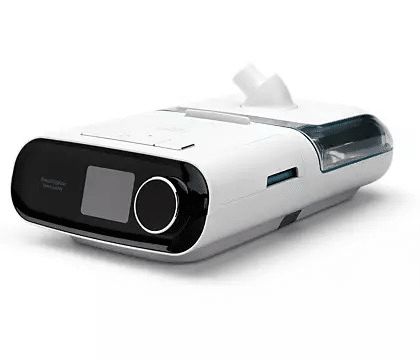
The DreamStation BiPAP, produced by Philips Respironics, is a popular choice known for its advanced technology and user-friendly interface. It offers auto-adjusting pressure settings to cater to individual needs and comfort. The machine incorporates features like a built-in heated humidifier, mask fit detection, advanced event detection, and connectivity options for data tracking. Users praise its quiet operation, comfort features, and effectiveness in improving sleep quality.
These advanced BiPAP machines, along with the AirCurve BiPAP 10 VAuto and the Luna G3 BiPAP Machine, provide a diverse range of options for readers to consider. Each device has its features, benefits, and user feedback, allowing individuals to choose the one that best suits their needs and preferences.
BiPAP Accessories and Compatibility
To enhance your BiPAP therapy experience, several accessories are available. Each accessory is crucial in optimizing comfort, effectiveness, and overall hygiene.
Selecting The Right Masks
A suitable mask is essential for a comfortable and practical BiPAP therapy experience. Masks come in various styles, including nasal, full-face, and nasal pillow masks. Consider factors like mask fit, cushioning, and the ability to minimize leaks to find the most suitable option for your needs.
Headgear Options
Headgear is an integral part of wearing a BiPAP mask. It ensures a secure fit and stability during sleep. Look for headgear that is adjustable, comfortable, and designed to minimize pressure points. Properly fitting headgear can enhance therapy effectiveness and prevent discomfort.
The Role Of PAP Pillows
PAP pillows, also known as mask liners or cushions, can improve comfort and minimize mask leaks. These soft inserts fit between the mask and your face, providing a cushioning barrier that reduces pressure points and enhances the mask seal. PAP pillows can particularly benefit sensitive skin or those experiencing mask discomfort.
The Importance Of A Cleaner And Filters
Maintaining proper hygiene is crucial for BiPAP therapy. A dedicated BiPAP cleaner helps remove bacteria, germs, and residue from your mask and equipment. Regular cleaning can prevent the buildup of dirt, allergens, and unpleasant odors, ensuring a fresh and hygienic therapy experience.
Filters play a vital role in ensuring clean air intake during BiPAP therapy. They capture dust, pollen, and other airborne particles, preventing them from entering your airways. Regularly replacing filters is essential to maintain the efficiency and effectiveness of your BiPAP machine.
Exploring External Batteries
For individuals who require portability, external batteries are a valuable accessory. These batteries provide power to your BiPAP machine when an electrical outlet is not readily available. They allow you to use your BiPAP machine during travel or when access to electricity is limited.
Also Read: Best Batteries and Battery Backup for CPAP
The Benefits Of A Humidifier For Added Comfort
Humidifiers add moisture to the pressurized air delivered by your BiPAP machine, reducing dryness and irritation in the airways. This can enhance comfort, prevent nasal congestion, and alleviate symptoms like dry throat. Consider a humidifier option compatible with your BiPAP machine for optimal comfort.
The Role Of CPAP Hose In Delivering Airflow Efficiently
CPAP hose, also known as tubing or connectors, delivers the airflow from the BiPAP machine to your mask. Ensuring the CPAP hose is in good condition and adequately connected is essential to avoid air leaks. Consider options with insulated tubing for reduced condensation and quieter operation.
Selecting the right accessories that complement your needs and preferences is crucial for successful BiPAP treatment.
The Role Of A Healthcare Professional
A healthcare professional, such as a pulmonologist, sleep specialist, or respiratory therapist, plays a crucial role in prescribing BiPAP therapy. They will evaluate your medical history, conduct diagnostic tests, and assess your obstructive sleep apnea or respiratory condition to determine if BiPAP therapy is necessary.
Based on their evaluation, they will provide a prescription specifying the recommended settings, pressure range, and any other requirements for your BiPAP treatment.
Real-Life Success Stories: BiPAP Therapy Transforming Lives
These personal accounts and experiences can provide a deeper understanding of how this therapy can significantly improve sleep quality and overall health and well-being for individuals with CSA.
1st patient testimony:
To begin with, consider the case of a middle-aged man diagnosed with CSA after years of struggling with excessive daytime sleepiness, unrefreshing sleep, and cognitive difficulties. Upon starting the therapy, he experienced a marked improvement in his sleep quality, with fewer awakenings during the night and a noticeable reduction in daytime sleepiness. As a result, he found that his ability to concentrate at work improved, and he could again enjoy recreational activities without constant fatigue.
2nd patient testimony:
Another example involves a woman with CSA and heart failure who faced multiple health challenges due to her sleep disorder. After initiating this therapy, she reported fewer episodes of shortness of breath and improved sleep quality. Over time, her heart function stabilized, and her overall quality of life significantly improved, allowing her to resume her daily activities with greater ease and confidence.
3rd patient testimony:
In yet another instance, a senior with CSA experienced a dramatic turnaround in his sleep patterns after adopting BiPAP. Previously plagued by sleep disorders, restless sleep, and frequent awakenings, he found that BiPAP treatment allowed him to sleep soundly through the night. This led to decreased morning headaches, a common symptom of sleep apnea, and an overall improvement in his mood and energy levels.
Limitations and Challenges of BiPAP Therapy
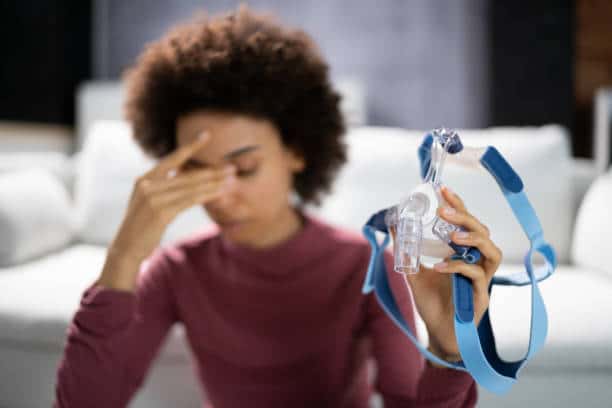
While BiPAP therapy has proven to be a promising and effective treatment for many Central Sleep Apnea (CSA) patients, it is essential to acknowledge the limitations and challenges associated with this therapy. Patients and healthcare providers can make informed decisions and work together to optimize treatment outcomes by understanding these drawbacks
Possible side effects and discomfort
Some patients may initially experience side effects or discomfort when starting this therapy. Common issues can include:
- Nasal congestion.
- Dry mouth.
- Skin irritation from the mask.
- Difficulty adjusting to the sensation of pressurized air during sleep.
However, most side effects can be mitigated through proper mask fitting, a humidifier, and gradual acclimatization to the therapy.
Adherence to treatment
As with any long-term therapy, adherence to BiPAP treatment can be challenging for some patients. The need to wear a mask during sleep and the potential discomfort associated with the therapy may lead to inconsistent use, reducing its effectiveness. To improve compliance, patients must work closely with their healthcare providers to find the most comfortable mask and settings that suit their needs.
Financial considerations and insurance coverage
The cost of a BiPAP machine and associated supplies can be a barrier for some patients. Although many insurance plans cover BiPAP therapy, the extent of coverage can vary, and some patients may face out-of-pocket expenses. Researching insurance coverage and exploring potential financial assistance programs is crucial to ensure the therapy remains accessible and affordable.
Access to qualified healthcare providers and support
To achieve the best results with BiPAP, patients need access to qualified sleep specialists, respiratory therapists, and ongoing support. However, depending on the patient’s location and available resources, finding the appropriate care and support may take time and effort.
Conclusion
BiPAP therapy has emerged as a promising treatment option for individuals with Central Sleep Apnea, addressing the unique challenges posed by this sleep disorder. By providing dual-levels of air pressure, enhanced comfort, and personalized therapy, BiPAP machines have the potential to improve central sleep apnea, sleep quality, alleviate symptoms, and mitigate the risks associated with untreated CSA.
Despite certain limitations and challenges, ongoing advancements and innovations in the field promise even more effective and accessible treatment options in the near future.
Suppose you or a loved one are experiencing sleep apnea symptoms or have already been diagnosed with Central Sleep Apnea. In that case, we encourage you to consult a sleep specialist to discuss your treatment options.
Taking proactive steps to address your sleep disorder can improve your overall health, well-being, and quality of life. Don’t wait to start your journey towards better sleep – take action today and rediscover the restorative power of a good night’s sleep.
To enhance your BiPAP therapy experience, visit our Amazon shop for a wide selection of BiPAP accessories. Our products are designed to provide you with the comfort and personalization your therapy needs.



